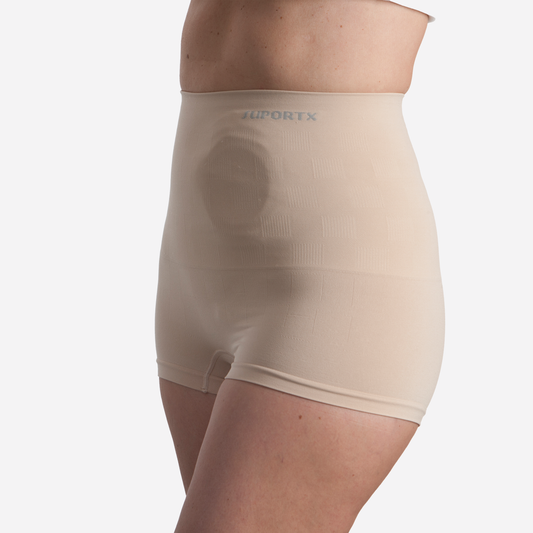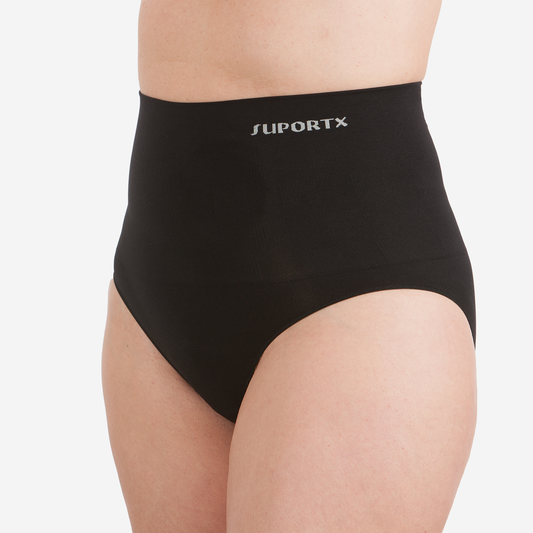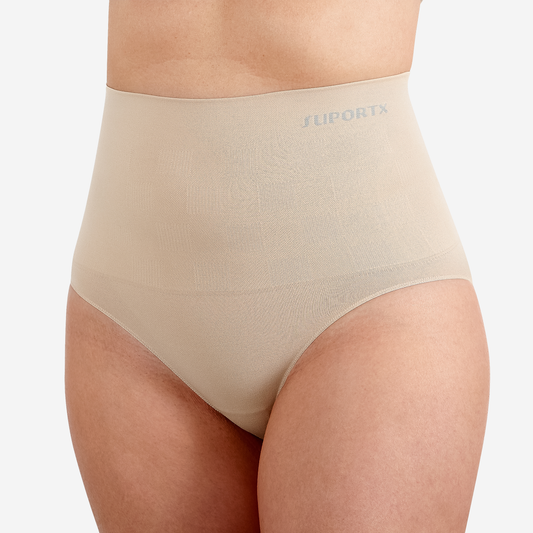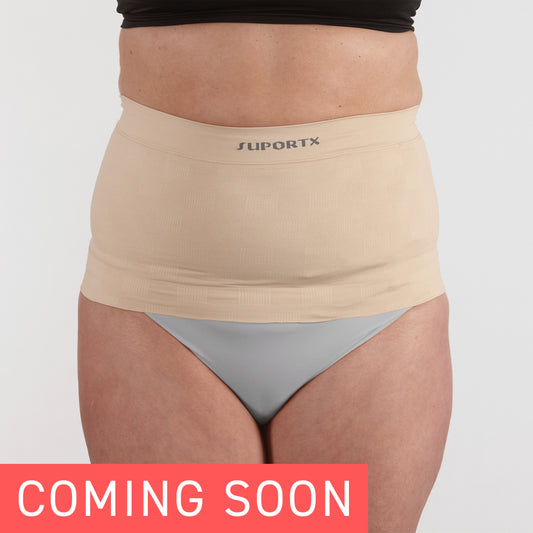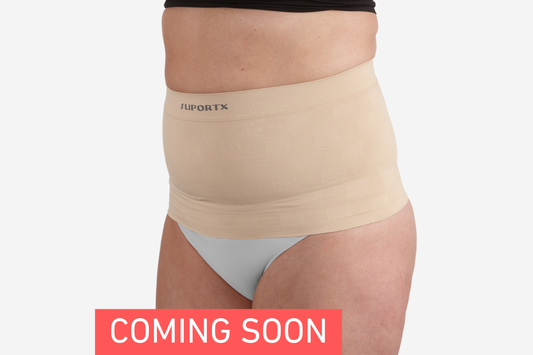Explore how ostomy support garments have advanced over the years, offering better comfort, discretion, and support. Learn about key innovations designed to enhance daily life for ostomates.
When we’re feeling unwell, it’s natural to reach for those little things that bring relief - a hot water bottle for body aches, a cold compress for a pounding headache. For ongoing conditions like arthritis or swelling, compression garments often become trusted companions. These small comforts remind us just how much modern medicine has evolved, giving us tools to feel better and live more comfortably.
But medicine isn’t just about quick fixes. It’s about big, bold ideas that change lives. Take stoma surgeries, for example - an incredible procedure that saves lives by doing something most of us wouldn’t have thought possible: bringing the inside to the outside. It’s a marvel of human ingenuity. But innovation doesn’t stop at treatment - it extends to prevention and quality of life, too. That’s where support garments come in.
Support garments are more than just a medical tool - they’re a game-changer. They protect stomas, help prevent hernias, and provide a sense of security, all while offering comfort and discretion. These garments not only make life easier but also help people feel like themselves again, with confidence to move through the world without worry.
But here’s the real question: who came up with the idea of a belt to protect a stoma? How did a simple concept evolve into the modern, highly effective support garments we see today? And what’s next for this humble yet life-enhancing accessory?
Let’s dive into the fascinating history of support garments and uncover the story behind this remarkable evolution.
Table of Contents
The Origin of Support Garments
The journey of support garments is as old as civilization itself, intertwining practicality, medicine, and the quest for comfort. Stoma surgeries, which are life-saving procedures for many today, can be traced back to as early as 350 BC.
The recorded history of ostomy surgery officially began in 1750, with the first colostomy. At the time, there was little distinction between a colostomy and an ileostomy, but this marked the foundation of modern stoma care.
Compression therapy, a cornerstone in medical treatment, has roots just as ancient. Ancient Greeks and Romans used bandages to promote healing and provide support, while early writings in the Corpus Hippocraticum (450–350 BC) discussed the benefits of applied pressure (Pelican Healthcare, 2020).
By the 15th century, bandages were being used to treat varicose veins, and in the 19th century, elastic compression stockings designed for gradual compression were developed (Geoffrey, 2023). These advancements laid the groundwork for the support garments we know today.

(Wikipedia, 2025)
In the mid-20th century, compression garments began to expand beyond medical purposes to include lifestyle applications. Nylon stockings, for example, became a popular compression garment for women, offering both style and health benefits.
By the 1950s, athletes started experimenting with compression clothing to improve performance and aid recovery. Over the decades, specialized designs emerged, catering to various needs, from postoperative care to enhancing athletic endurance (Amber, 2024).
Parallel to these advancements was the evolution of shapewear. Greeks and Romans used primitive compression garments to enhance body shapes, while corsets became a staple during the Middle Ages.
Though often restrictive and uncomfortable, corsets persisted into the 19th century, when the Industrial Revolution introduced mass production.
The invention of elastic materials like Spandex in the 20th century transformed shapewear, making it both more comfortable and effective, eventually evolving into a tool for body confidence and support (Shapengo Limited, 2023).


Fig. 1: (Corset Story, 2022)
Fig. 2: (Invent, 2025)
These historical advancements paved the way for the modern stoma support garment, which combines elements of compression, comfort, and functionality.
The introduction of stoma surgeries highlighted a need for specialized support.
Initially, ostomates relied on makeshift solutions to protect their stomas and secure ostomy pouches. Early support garments were rudimentary—essentially elasticated bands that offered minimal support.
In 1996, patents began to formalize the design of ostomy-specific support belts (Google Patents, 1996).
These belts were designed to not only secure the ostomy pouch but also provide discreet coverage, allowing individuals to engage in everyday activities with greater confidence.
The belt's innovation included features like expandable pouches for discharge, improved accessibility for pouch removal and cleaning, and a snug fit to prevent discomfort during movement.

(Google, 1996)
As demand for tailored solutions grew, manufacturers began refining stoma support garments, incorporating learnings from compression therapy and shapewear.
The evolution included advancements such as breathable materials, adjustable fits, and garments tailored to prevent hernias—a common concern for ostomates.
Over time, the scope of support expanded to include briefs, girdles, and wrap-around belts, offering a variety of choices for ostomates to suit their individual needs.
Further Readings
The Evolution of Stoma Support Garments
Today, stoma support garments are an essential part of post-surgical care and daily life for many. These garments not only provide physical support but also restore confidence by ensuring discretion and comfort.
From ancient bandages to modern ostomy belts, the evolution of support garments reflects a remarkable journey of innovation, shaped by the changing needs of individuals and the relentless pursuit of improving quality of life.
It’s hard to imagine life without modern ostomy care, but for the first patients to undergo stoma surgery, managing waste was a daily battle.
The first recorded successful colostomy was performed in 1820 on a woman named Mrs. Margaret White (Tidings 58, 2020). While the procedure saved her life—an incredible feat for the time—there was one major issue: there was no ostomy bag. Instead, she had to rely on whatever she could find to catch waste, including cushions, rags, towels, or even a bucket.

(British Library, 2022)
As more patients underwent stoma surgery, doctors quickly realized that a solution was needed. Early records from the 19th century describe complications such as skin ulcers, infections, and stoma prolapse , all of which were made worse by the lack of proper appliances. But with ostomy surgery considered a "secret surgery" and used only as a last resort, progress was slow (The New York Times, 1982).
The Desperate Measures of Early Ostomates
Before the invention of the first ostomy bags, patients were left to fend for themselves, often resorting to bizarre and creative solutions. Some of the makeshift collection methods included inner tubes from bicycle tires, rags and towels, and even bread bags!
But waste collection wasn’t the only issue - odor control was another major concern. Ostomates tried to mask the smell with various household items, including baking soda and peppermint extract (Pelican Healthcare, 2025).
Sadly, these methods often did little to help. Many ostomates became isolated from society , afraid of embarrassment, leaks, and unpleasant smells.

The Struggle with Skin Care
Without proper appliances, peristomal skin problems were rampant. Constant exposure to waste led to severe irritation, and ostomates tried whatever they could to protect their skin, including using talcum powder, corn starch, and aluminum paste.
These solutions were far from ideal, but they were the best available at the time.
The Game-Changer: The First Stoma Bags
Everything changed in the early 1950s when the first ostomy appliances hit the market. Initially, these were bulky, rubber-based pouches combined with plastic materials to improve aesthetics. While rudimentary by today’s standards, these early appliances gave ostomates a level of freedom they had never known before (Meet An Ostomate, 2025).
At the same time, major advances in skin protection were taking place. A key development was karaya , a natural gum that acted as the first real peristomal skin barrier. Though revolutionary, it had its flaws—some patients developed allergic reactions , and it didn’t hold up well for those with liquid output (Pelican Healthcare, 2025).

(Pelican Healthcare, 2025)
Still, these early ostomy bags and skin barriers were life-changing.
For the first time, ostomates could leave their homes with confidence , knowing their appliance would stay in place.
These innovations paved the way for the sophisticated, discreet, and reliable ostomy care products we have today.
The Evolution of Ostomy Care: From Early Stoma Appliances to Modern Support Garments
For those living with an ostomy, comfort and confidence go hand in hand. But achieving both hasn’t always been easy. Over the years, ostomy appliances have evolved dramatically, transforming from rudimentary collection methods to advanced pouching systems.
Yet, as these appliances improved, a new challenge arose—the need for reliable support garments that provide security, reduce strain, and help ostomates move freely in daily life.
The history of ostomy care is not just about medical advancements but also about the people who pushed for better solutions. One such pioneer was Elise Sørensen, a Danish nurse whose sister, Thora, had undergone ostomy surgery in 1954.
Thora hesitated to leave home, fearing a public leak. Determined to help, Elise designed the world’s first disposable, self-adhesive ostomy pouch—an invention that would change ostomy care forever.

(Coloplast, 2025)
Recognizing the potential of Elise’s idea, Aage Louis-Hansen, a civil engineer and plastics manufacturer, and his wife Johanne Louis-Hansen, a nurse, brought the design to life, developing the first ostomy bag.
This marked a major breakthrough, offering ostomates a more discreet and reliable way to manage their condition. But while the new pouches improved waste collection, they introduced a fresh challenge: how to keep them secure, comfortable, and discreet during movement.
This need led to the development of ostomy support garments , providing the structure and reassurance that modern ostomates rely on today.
How Ostomy Appliances Advanced
Before innovations like Sørensen’s pouch, ostomates had few reliable options. In the 19th century, they used fabric or metal contraptions, and by the early 20th century, makeshift plastic bags were common. The 1940s and 1950s saw the introduction of reusable rubber appliances, but these required multiple steps—applying adhesive, taping down a rigid plate, and stretching a rubber pouch over it. They were functional yet cumbersome and prone to leaks.
Over the last few decades, ostomy technology has advanced significantly (A Bigger Life, 2025):
Soft fabric covers make pouches discreet and water-repellent.
Improved filters help manage gas buildup.
Hydrocolloid skin barriers cater to different wear times, from frequent (3–4 times a day) to extended wear (3–4 days).
Closure systems have evolved from bulky clips to sleek Velcro fastenings for easier emptying and security.

(Gilpin et al., 2024)
These advancements dramatically improved ostomy management, but as pouches became more refined, ostomates faced another issue - how to keep their appliances secure and comfortable throughout daily activities.
The Rise of Ostomy Support Garments
Early ostomates relied on makeshift methods like tight bandages, restrictive belts, or modified undergarments to hold their pouches in place. These solutions, however, often led to discomfort, skin irritation, and even hernias due to uneven pressure.
Recognizing this gap, medical designers in the 1990s introduced the first ostomy support belts, offering structured security for pouch users.
As time went on, these belts evolved alongside compression technology , leading to a new generation of high-performance support garments designed to:
- Prevent hernias by reducing abdominal strain.
- Provide stability to keep pouches in place during movement.
- Enhance discretion and comfort for a smoother fit under clothing.

(Pittman, Colwell, and Mulekar, 2022)
Today, stoma support garments range from light compression wraps to firm support belts , ensuring that every ostomate can find a solution that fits their lifestyle.
Just as ostomy appliances have transformed over the years, support garments have evolved to meet the changing needs of ostomates—offering not just practicality, but also peace of mind.
The evolution of support garments reflects a long history of ingenuity, problem-solving, and a commitment to improving quality of life.
From ancient compression techniques to the first ostomy appliances and modern, high-performance support garments, each advancement has brought greater comfort, security, and confidence to ostomates.
As technology and materials continue to improve, the future promises even more refined solutions, ensuring that individuals with stomas can live their lives with greater ease and freedom.
References
A Bigger Life. (2025). How ostomy products have evolved over the years. [online] Available at: https://abiggerlife.com/to-a-bigger-life/how-ostomy-products-evolved-article/ .
Amber, L. (n.d.). The History of Compression Garments in Sports | Lunatik Athletiks. [online] Available at: https://www.lunatikathletiks.com/2019/08/21/the-history-of-compression-garments-in-sports/ .
British Library. (2022)
Colostomy, 18th century - Stock Image - C026/8262. [online] Science Photo Library. Available at: https://www.sciencephoto.com/media/693180/view/colostomy-18th-century [Accessed 27 Mar. 2025].
Coloplast (2025). Our story - Corporate. [online] Coloplast.com. Available at: https://www.coloplast.com/about-coloplast/history/?srsltid=AfmBOorNKCaBwLjIdzvhRlgziRMBdiSWeONgf6CW9BExjtYMHrR6hgRQ [Accessed 27 Mar. 2025].
Gilpin, V., Magee, N., Scott, C., L. Kirsty Pourshahidi, Chris, Ellen, McCreadie, K. and Davis, J. (2024). Evolution of Ostomy Pouch Design: Opportunities for Composite Technologies to Advance Patient Care. Journal of Composites Science, [online] 8(10), pp.388–388. doi: https://doi.org/10.3390/jcs8100388 .
Geoffrey (2023). The History of Compression Wear. [online] Alpha-U Technical Apparel. Available at: https://alphautech.com/the-history-of-compression-wear/ .
Google Patents. (1996). US5626570A - Ostomy appliance belt - Google Patents. [online] Available at: https://patents.google.com/patent/US5626570A/en [Accessed 27 Jan. 2025].
Invent. (2025) Available at: https://www.invent.org/inductees/joseph-c-shivers-jr#:~:text=One%20of%20the%20top%20clothing,fiber%20known%20generically%20as%20spandex.
Meet An Ostomate. (2025). The History of the Ostomy Part One! [online] Available at: https://www.meetanostomate.org/discussion-forum/viewtopic.php?t=28175 [Accessed 29 Jan. 2025].
Pelican Healthcare. (2020). History Behind the Stoma. [online] Available at: https://www.pelicanhealthcare.co.uk/history-behind-the-stoma/ .
Pelican Healthcare. (2025). History of Stoma Care and Appliances - Pelican Healthcare. [online] Available at: https://www.pelicanhealthcare.co.uk/history-of-stoma-care-and-appliances/ .
Pittman, J., Colwell, J. and Mulekar, M.S. (2022). Ostomy Complications and Quality of Life of Ostomy Support Belt/Garment Wearers. Journal of Wound, Ostomy, and Continence Nursing, [online] 49(1), pp.60–68. doi:https://doi.org/10.1097/WON.0000000000000843.
Shapengo Limited (2023). The Evolution of Shapewear: A Journey Through Time. [online] Shapengo. Available at: https://shapengo.co.uk/blogs/lifestyle-wellness/the-evolution-of-shapewear-a-journey-through-time?srsltid=AfmBOor4YqGfwnRsamVUFi8AqvSV5o7rs2f5R3NXQHVok2fEd72oEWD_ [Accessed 27 Jan. 2025].
Story, C. (2022). The History of Corsets - a journey through the ages. [online] Corset Story UK. Available at: https://corset-story.co.uk/blogs/news/the-history-of-corsets?srsltid=AfmBOoq15qk3_ivCoHWdBHWhPVVJqNj4gaYOlRESV9ksGEs2ORVA4laJ [Accessed 27 Mar. 2025].
The New York Times. (1982). Available at: https://www.nytimes.com/1982/05/03/style/ostomies-no-longer-the-secret-surgery.html [Accessed 29 Jan. 2025].
Tidings 58. (2020). Available at: https://www.colostomyuk.org/wp-content/uploads/2020/06/Tidings_Issue58.pdf [Accessed 29 Jan. 2025].
Wikipedia. (2025). Available at: https://en.wikipedia.org/wiki/Bandage#/media/File:Akhilleus_Patroklos_Antikensammlung_Berlin_F2278.jpg

